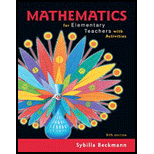
Concept explainers
Due to its high population, China has a stringent policy on having children. In rural China, couples are allowed to have either 1 or 2 children according to the following rule: If their first child is a boy, they are not allowed to have any more children. If their first child is a girl, then they are allowed to have a second child. Let’s assume that all couples follow this policy and have as many children as the policy allows.
a. Do you think this policy will result in more boys, more girls, or about the same number of boys as girls being born? (Answer without performing any calculations—just make a guess.)
b. Now consider a random group of 100,000 rural Chinese couples who will have children. Assume that any time a couple has a child the probability of having a boy is
i. In the ideal, how many couples will have a boy as their first child, and how many will have a girl as their first child?
ii. In the ideal, of those couples who have a girl first,how many will have a boy as their second childand how many will have a girl as their secondchild?
iii. Therefore, overall, what fraction of the childrenborn in rural China under the given policy shouldbe boys and what fraction should be girls?
Want to see the full answer?
Check out a sample textbook solution
Chapter 16 Solutions
Mathematics for Elementary Teachers with Activities (5th Edition)
- If P(AB)=0.7, is it possible that P(BA)=0.6? Explainarrow_forwardIs it possible that P(AB)=P(A)? Explain.arrow_forwardA family consisting of 2 parents and 3 children is to pose for a picture with 2 family members in the front and 3 in the back a. How many arrangements are possible with no restrictions? b. How many arrangements are possible if the parents must sit in the front? C. How many arrangements are possible if the parents must be next to each other?arrow_forward
- How many permutations of the letters W, X, Y, and Z are possible?arrow_forwardIn how many ways can 5 people stand in a line if one person demands to be first?arrow_forwardA hospital cafeteria offers a fixed-price lunch consisting of a main course, a dessert, and a drink. If there are four main courses, three desserts, and six drinks to pick from, in how many ways can a customer select a meal consisting of one choice from each category?arrow_forward
 Trigonometry (MindTap Course List)TrigonometryISBN:9781305652224Author:Charles P. McKeague, Mark D. TurnerPublisher:Cengage Learning
Trigonometry (MindTap Course List)TrigonometryISBN:9781305652224Author:Charles P. McKeague, Mark D. TurnerPublisher:Cengage Learning Algebra and Trigonometry (MindTap Course List)AlgebraISBN:9781305071742Author:James Stewart, Lothar Redlin, Saleem WatsonPublisher:Cengage Learning
Algebra and Trigonometry (MindTap Course List)AlgebraISBN:9781305071742Author:James Stewart, Lothar Redlin, Saleem WatsonPublisher:Cengage Learning College AlgebraAlgebraISBN:9781305115545Author:James Stewart, Lothar Redlin, Saleem WatsonPublisher:Cengage Learning
College AlgebraAlgebraISBN:9781305115545Author:James Stewart, Lothar Redlin, Saleem WatsonPublisher:Cengage Learning
 Elementary Geometry For College Students, 7eGeometryISBN:9781337614085Author:Alexander, Daniel C.; Koeberlein, Geralyn M.Publisher:Cengage,
Elementary Geometry For College Students, 7eGeometryISBN:9781337614085Author:Alexander, Daniel C.; Koeberlein, Geralyn M.Publisher:Cengage, Algebra: Structure And Method, Book 1AlgebraISBN:9780395977224Author:Richard G. Brown, Mary P. Dolciani, Robert H. Sorgenfrey, William L. ColePublisher:McDougal Littell
Algebra: Structure And Method, Book 1AlgebraISBN:9780395977224Author:Richard G. Brown, Mary P. Dolciani, Robert H. Sorgenfrey, William L. ColePublisher:McDougal Littell





